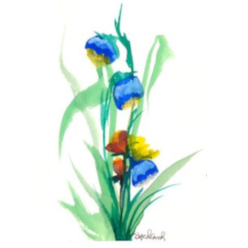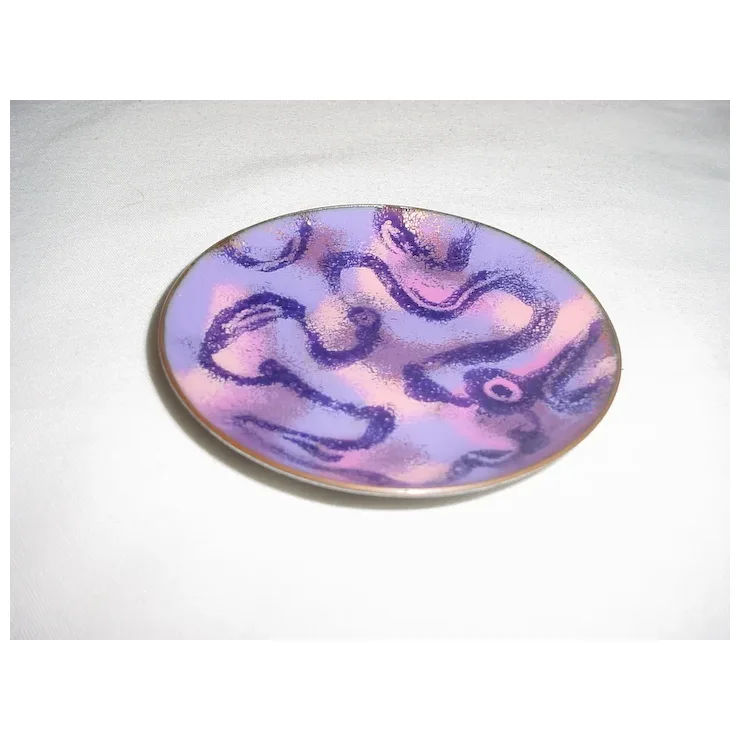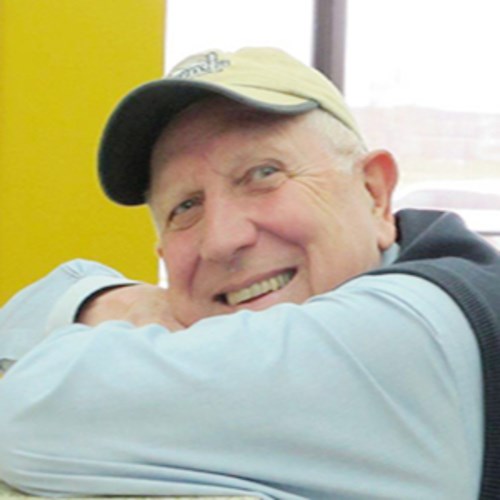Thank Robert Bachrach for providing this pdf.
Year: 2023
Early Lilyan Bachrach enamel featured on rubylane
Robert Bachrach found the following link:
https://www.rubylane.com/item/1470117-1360/Unusual-Signed-Original-Vintage-Modern-Enamel
To keep the content much of it is repeated here.
HERE’S AN UNUSUAL SIGNED ORIGINAL VINTAGE MODERN ENAMEL-ON-COPPER PLATE CREATED BY WORCESTER, MASSACHUSETTS ARTIST LILYAN BACHRACH (1917-2015) THAT DISPLAYS AN ATYPICAL DESIGN BY THE ARTIST OF A SPONTANEOUS ABSTRACTION RENDERED IN PURPLE, PINK, BLACK, AND OFF-WHITE ENAMELING!
Dimensions: The plate measures approximately three and three fourths inches (3 3/4”) in diameter by one half of an inch (1/2”) in height.
Please Note: Bachrach created one of her less frequently found abstract designs on the plate’s interior made up of wavy amorphous black enameled lines set against a variegated purple, pink, and off-white enameled background. When turned to the proper vantage point, the wavy amorphous black enameled lines take on the somewhat representational form of a flying bird with its beak open. The plate’s underside is counter enameled with speckled dark blue enamel that transitions to a bluish-white enamel where Bachrach’s signature is located.
Signature: Signed on the underside bottom in reddish enamel “Bachrach” In addition, there is an original artist’s silver paper label that appears to read: “Bachrach Enamels Worcester”
Condition: Excellent and clean condition – essentially flawless! There is some wear to the artist’s paper label so that it is difficult to read without the use of a magnifying glass. Otherwise, this is an unusual example of Lilyan Bachrach’s abstract enamel art!
Domestic buyer pays calculated shipping for secure packing and USPS priority within the United States. I no longer ship internationally due to the high volume of scams taking place. Sorry.
Lilyan Bachrach’s Autobiography:
I was born 1/7/17 New Haven, Connecticut (and) moved to Lowell, Massachusetts about 1921 with my parents and my sister, Elaine, who was born in 1919.
Through High School, I worked on Saturdays and summers in my parents’ curtain and drapery store in Lowell, MA. My father manufactured curtains and draperies in the basement of that store. From him I learned to appreciate good fabrics and figure out how many yards of fabric were needed to make a certain number of pairs of ruffle curtains. In time I became the designer of the curtains and draperies we made for the three stores that they owned. From my father I learned to inspect what we made, always looking for any faults. His favorite question was, “Can you make it better?” I still look at my own work in almost the same way. If there is a fault, it is the first thing I spot. If the piece holds together, then I know it is acceptable.
After High School, in 1934 I enrolled at Boston University because my father said I had to live at home. A group of us commuted by train five days a week into North Station and shared a taxicab to school. I was studying to be an Interior Decorator. In my second year I made a new school friend from Maynard, MA. She fixed me up on a blind date with her brother’s friend, Sam Bachrach, who was at Tuft’s Medical School. On our first date he bought me a coca-cola and watched me drink it. I didn’t know he didn’t have enough money to buy one for himself. It was later that I learned that he would buy a quart of milk, transfer the milk to a pitcher, take the bottle back for the deposit so he could buy a can of beans. It was still depression days. At the end of my second year, my sister, who was two years younger, was ready for college. Because my parents could not afford to send both of us to school and I was planning to be the decorator for the stores, I offered to leave college. My father let her live at school at the University of Vermont. There she met her future husband and left school after her first year. I continued seeing Sam and we drifted into marriage plans in 1938 when he graduated from medical school. We had two daughters and two sons, born from 1940 to 1959. Sam died in 1988, just after our 50th anniversary.
In 1936 my parents had moved to Worcester, Massachusetts. I lived at home with my parents while Sam was a medical resident and then an intern. Our first child, Barbara, was born in September 1940 just before Sam was called into the Army Medical Corps as a First Lt. He had been in ROTC in college. He thought he would do his year of service and then be a civilian again. Pearl Harbor changed that and his tour of duty stretched to five years. Our son, Robert, was born in June 1940. The four of us traveled first to Fort Adams, then to Fort Dix, to Mitchell Field and to Orlando, Fl where Sam set up the medical school for the Army. At that point he had been to flight surgeon school and was a Major in the Army Air Force. He went overseas and I went home to my parents in Worcester, MA. At the end of the war, he returned and in 1947, Benjamin was born. We now had 3 children, one pre-war, one war and one post-war. Sam set up in private practice in Worcester and in 1959 Elizabeth was born. We called her our “bonus”.
During World War II, my father had closed his stores and retired. To keep my mind off the war when I moved with the two children back to Worcester, I went into the business of making children’s hand smocked dresses. I bought the fabrics , chose the embroidery thread colors, cut out the dresses from size 2 to size 8, stamped the dots for the smocking and trained other wives to do the smocking and some to do the stitching. I remember that my main account was Crawford Hollidges in Boston, MA. With the arrival of Benjamin in 1947, my business came to an end.
After the war, while Sam’s medical practice was growing, I was keeping house and taking care of our three children. I did his bookkeeping at home and became active in non-profit organizations. I always liked to make beautiful things. I studied sewing, tray painting, oil painting, silversmithing and jewelry. Even tried pottery but that did not fit in with my life style…it took too long to clean up. When I discovered enameling in 1955, it was just right. With a smock over dress clothes, I could turn off the kiln and leave my work bench within five minutes.
To go back before 1955, I had been studying silversmithing at our Worcester Craft Center when my instructor decided to teach enameling. My friend, Bernice Morse, and I signed up. I assumed it would be like the oil painting I had been doing. She loved the class. I didn’t. They were copying small pictures or making solid color pieces to set instead of stones. I went back to silversmithing but she stayed with it. Then the craft center raised their classroom fees and my friend thought it would be less expensive to get a group together to set up a workshop in one of our homes. She asked me to help her organize a group. We easily found 8 other housewives, put in $40 each, ordered equipment and supplies and set up a workshop in Miriam Casdin’s basement. Her house was the nearest to Bernice who didn’t drive so that was why we chose Miriam’s. We soon had to add another $40 each to be able to have a larger selection of enamels and copper forms. Miriam lived on Lenox Street, so we called ourselves the Lenox Enamelers. Our husbands thought it was funny and that we would not last together more than a year. We lasted for five years…and by then five of us had our own kilns and workshops in our homes. My first one had an 8” kiln in the pantry off the kitchen.
We were lucky. When the studio was all set up, Doris Hall announced that she would give demonstration lessons. Five of us signed up and drove to Boston to her studio once a week for I think 6 weeks. During the week, we practiced in our workshop and showed the other members what we had learned. Because she handled enamels as a painter’s medium, I fell in love with enamels because of the infinite range of colors and their tactile quality. Shortly after that, Joseph Trippetti arrived at the Craft Center to teach enameling. I studied cloisonné with him for two years. At his urging, I taught enameling for four years to the adult classes at the Worcester Trade School. At that time, physicians were not under Social Security and I assumed that as a teacher there I would be. I was wrong. The city employees were not under Social Security. However, I enjoyed the teaching. The school required that I take the course in Methods of Teaching Adults at the Fitchburg State College. To my surprise, I did very well even though it was a good many years since I had been in a classroom. The first two years I taught beginners and the second two years the advanced group. By then I had had enough even though it was just one night a week.
When Elizabeth our fourth child, was six years old, I had lots of help at home so I applied and was accepted as a full time student at the School of the Worcester Art Museum. My portfolio consisted of my enamels that the director liked. Sam used to get a kick out of saying that we couldn’t go out on a certain evening because his wife had homework to do. I loved art school even though I was the oldest one in the class. There were two other women who were also mothers in that class. I thought I was going to learn to paint like Rembrandt. It was the wrong time in art history. When at the first painting class the instructor told us to just express ourselves, I asked him if he was kidding. To my disappointment, he was serious. However, I had many good teachers and along with learning to see I also learned the vocabulary and the language. I called it shooting the bull, which I couldn’t do then and I still can’t do it.
Throughout the years I studied enameling and/or silversmithing with Bill Kurwacz, Fiometta Shieh, Mary Kretsinger, Charles Jeffrey, Curtis LaFollette, and Tim McCreight, in addition to short workshops with Kenneth Bates, June Schwarcz, Earl Pardon, and Margaret Seeler.
In the 1970’s a group of volunteers organized a craft fair at the ski resort in Stowe, VT. We were 60 in all. From there it moved to Mt Snow, then to Bennington, VT and by the 5th or 6th year to Rhinebeck, NY because we had grown to so many numbers. Then it became a professional show, with a paid director and slides required to be accepted. I do not remember when we went under the wing of the American Craftsmen Council (ACC). It was at Rhinebeck, that we developed wholesale days prior to the retail days. Now the ACC holds “Markets” throughout the United States and accepts about 500 craftspeople from myriads of applications. I showed my one-of-a-kind overglaze painting enamels through Fair #9. For wholesale, I needed to make just an assortment of pieces to show the quality and size of the work. My customers would order the number of pieces in each size and could specify the predominating color or two colors. If they didn’t like what I sent to them, they could return them. Fortunately, there were no returns. When the time came to apply for Fair #10, I realized I was on a merry-go-round. I had just finished mailing out the last order when it was time to plan the next year’s display. I took that year off and never applied again. In the early days, the annual show was like attending a family reunion. It was wonderful. Today, it’s big business and expensive.
Over the years, my enamels were exhibited at the Worcester Center for Crafts, the Worcester Art Museum, Danforth Museum, DeCordova Museum, Fitchburg Art Museum, the Palo Alto Cultural Center – among others. The shops and galleries that handled my enamels included Gumps, Skera, Appalachian Spring, Voltaires, etc. Commission work ranged from cloisonné award pins to processional crosses, doors for an ark, chalice cups and 10ft architectural panels. My records were never up to date for I just didn’t have the time to do them. My husband was active in the community and whenever he served as President of an organization, I became the gal Friday behind the scenes. He started the Worcester County Poetry Assn, The Age Center of Worcester Area, and The Worcester Forum for the Study of Values.
I was fortunate that I grew up in a family with the work ethic and loved to be working at something. My husband, Sam, was my biggest booster and my best critic. I was also fortunate that I was able to purchase whatever I needed or wanted in my workshop. It was an ego trip when I received a check for my work. When Sam had a severe heart attack in 1977 and had to retire, I learned how different the time in the workshop felt when you knew you needed to sell your work. For most of us, it is a difficult way to make a living while doing what you love.
LILYAN BACHRACH (b. 1917-) BIO (courtesy Enamel Arts Foundation website)
Lilyan Bachrach’s work in enamel is remarkably wide-ranging and diverse. In a career spanning five decades she has produced an extraordinary body of work that includes jewelry, functional vessels, decorative plaques, switch plates, mezuzahs, and other religious and ceremonial forms. A superb craftsman, she is equally well-versed at abstraction and representation, cloisonné technique and overglaze painting. The lush floral images she portrays on her decorative plates are perfectly suited to the forms on which they are rendered and her enamel jewelry is invariably bold, inventive, and visually rich.
Lilyan Bachrach was born in New Haven, Connecticut in 1917. In 1921, when she was four, her family moved to Lowell, Massachusetts where her parents established a curtain and drapery manufacturing business and, over time, several retail shops. Through her parents Bachrach learned to appreciate fine fabrics as she developed a lifelong commitment to quality workmanship. After producing several textile designs for the family business, Bachrach enrolled in 1934 as a student at Boston University where she studied to become an interior designer. While there, through a mutual friend, she met her future husband, a student at Tuft’s Medical School. She and Sam Bachrach were married in 1938. While her husband served in the military during World War II, she raised their growing family and, after the War, helped manage Sam’s expanding medical practice.
In the early 1950s, she enrolled in a metals class at the Worcester Center for Crafts where, in 1955, she was introduced to enameling. While she found some of the initial classes limiting, she eventually participated with seven other women in an informal enameling workshop called the “Lenox Enamelers.” There she developed an abiding passion for the medium. As she later stated: “I fell in love with enamels because of the infinite range of colors and their tactile quality.” About this same time, she enrolled in a workshop under the direction of the Cleveland-trained artist Doris Hall, held at Hall’s studio in Boston. While the class met weekly for only six weeks, this experience had a profound influence on Bachrach’s development as an artist. As she observed later in life, Bachrach found Hall’s looser, more painterly approach to enameling refreshing and highly compatible with her own. She later studied cloisonné technique at the Worcester Center for Crafts with the masterful artist Joseph Trippetti and, over the years, participated in workshops led by a wide variety of artists including Mary Kretsinger, Charles Bartley Jeffery, Kenneth Bates, Fiammetta Hsieh, and others. In the late 1960s, Bachrach resumed formal studies at the Worcester Art Museum School where she was awarded a BFA in 1969.
Lilyan Bachrach also produced two important books on enameling technique. The first Enameling with Professionals was published in 2002 and the second, Contemporary Enameling: Arts and Techniques was published in 2006. A testament to the extraordinary work of her friends and colleagues, Bachrach’s publications are comprised of brief essays on enameling by artists working in diverse styles and formats. Her books offer unique insight into both form and process.
iPhone Photo Course – Roger Roberts
Roger Roberts provided the following file.
Richard Lance – RIP
Richard “Dick” Lance was born in Geneva, Illinois in 1931 and passed away on Thursday, August 4, 2022 peacefully at home surrounded by his family.
He was Professor Emeritus of Cornell University College of the Engineering Department of Theoretical and Applied Mechanics, a vocation he loved; teaching was his calling.
Dick is survived by his wife of 69 years, Virginia “Ginny” Lance; his three children, Cathy Lance (Christopher Dilger), Julie Lance (Steve Ball), and Fritz Lance (Kelly Kaufman Lance); and five grandchildren, Virginia Carroll (Bobby), Kristen Lance (Hilary Gram), Zach Ball, Erin Ball, Sandrine Lance Duboscq. He also has one great-grandchild, Cass Gram Lance.
Dick and Ginny retired to Chestertown in 1998. Dick was deeply involved with the Washington College Academy of Lifelong Learning and an avid photographer.
From 1969 – 1973, Dick was Ben Bachrach’s advisor in the Department of Theoretical and Applied Mechanics at Cornell University for both his Masters Degree and PhD. Without Professor Lance’s encouragement and enthusiasm, Ben would not have completed his PhD program that led him to be a research engineer at Ford Motor Company.


